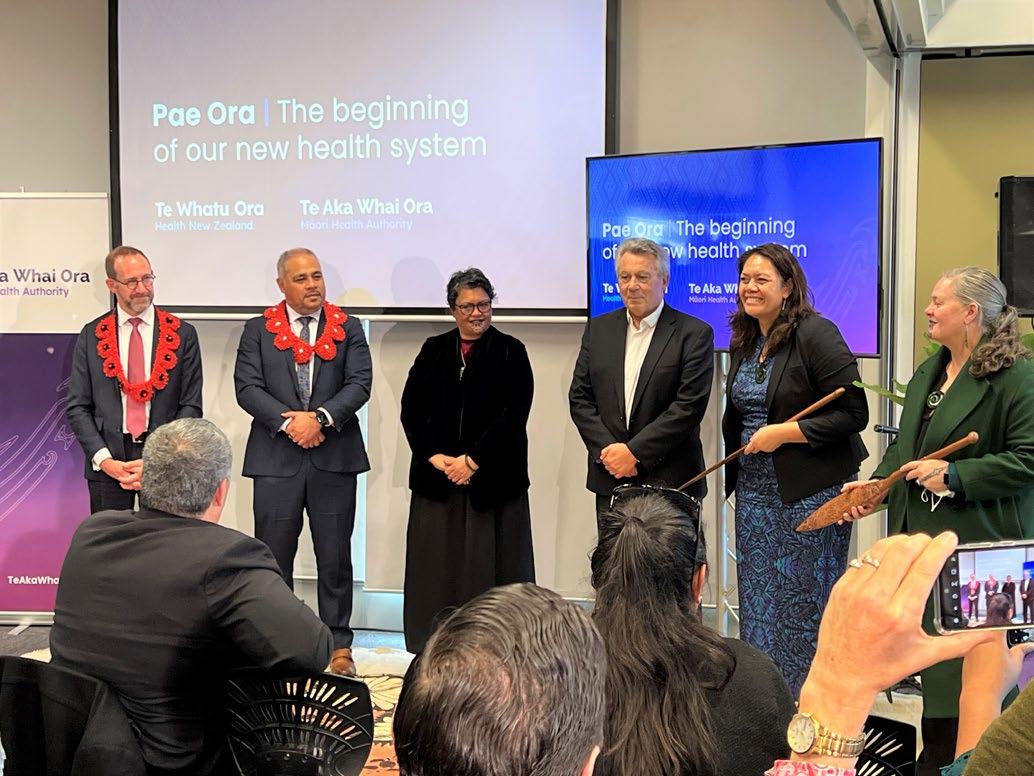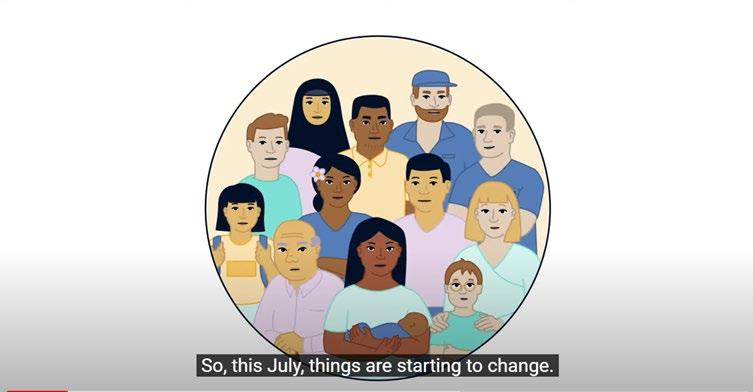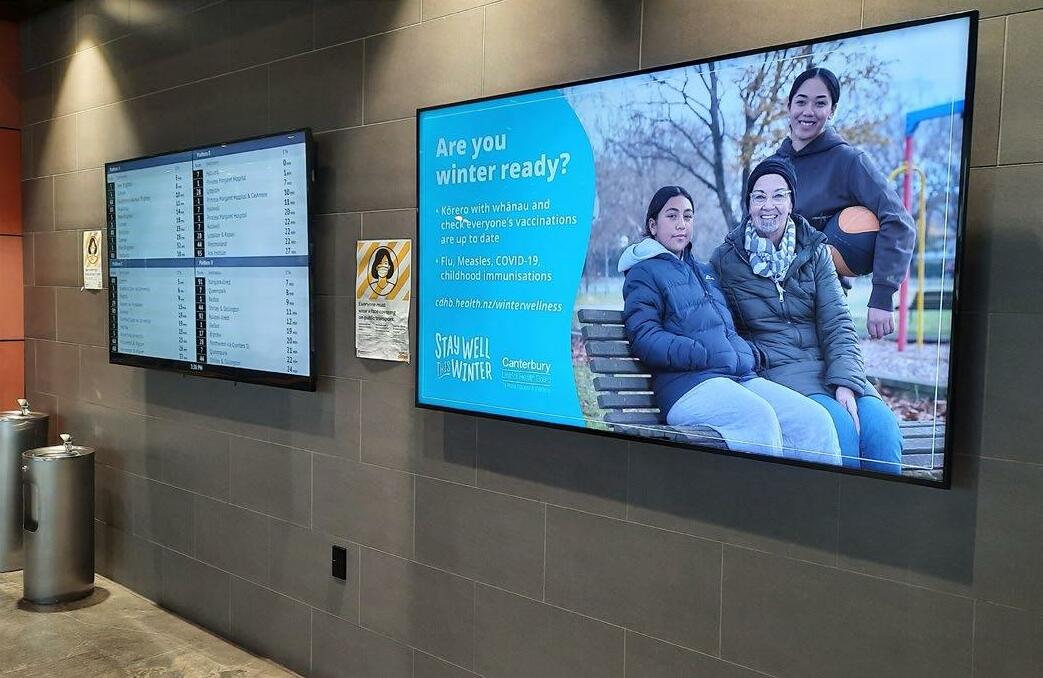
9 minute read
Kupu Arataki – Introduction Ā mātou tāngata – Our people
Kupu Arataki – Introduction
Welcome to Te Whatu Ora - Waitaha Canterbury
Advertisement
We are now officially part of a nationwide ‘team of teams’ with more than 80,000 colleagues around the country.
The 20 former DHB areas are now known as districts and they are grouped into four regions. Importantly, all your contacts in other districts still have the same contact details such as email addresses and websites. Here’s a list of the new region and district names:
District descriptors
Region District
Northland
District Descriptor
Te Whatu Ora – Health New Zealand Te Tai Tokerau
Northern
Waitematā
Te Whatu Ora – Health New Zealand Waitematā Auckland Te Whatu Ora – Health New Zealand Te Toka Tumai Auckland Counties Manukau Te Whatu Ora – Health New Zealand Counties Manukau
Te Manawa Taki
Waikato Lakes Bay of Plenty Tairāwhiti Taranaki Te Whatu Ora – Health New Zealand Waikato Te Whatu Ora – Health New Zealand Lakes Te Whatu Ora – Health New Zealand Hauora A Toi Bay of Plenty Te Whatu Ora – Health New Zealand Tairāwhiti Te Whatu Ora – Health New Zealand Taranaki
Central
Te Waipounamu
MidCentral Te Whatu Ora – Health New Zealand Te Pae Hauora o Ruahine o Tararua MidCentral
Whanganui Capital & Coast/Hutt Valley Hawke’s Bay Wairarapa Te Whatu Ora – Health New Zealand Whanganui
Te Whatu Ora – Health New Zealand Capital, Coast and Hutt Valley
Te Whatu Ora – Health New Zealand Te Matau a Māui Hawke’s Bay Te Whatu Ora – Health New Zealand Wairarapa Canterbury/West Coast Te Whatu Ora –Te Whatu Ora –Health New Zealand Waitaha Canterbury Health New Zealand Te Tai o Poutini West Coast
Nelson Marlborough Te Whatu Ora – Health New Zealand Nelson Marlborough Southern Te Whatu Ora – Health New Zealand Southern South Canterbury Te Whatu Ora – Health New Zealand South Canterbury
As previously advised very little changed on day one. Unfortunately, we did have some technical challenges on Friday and not everyone received their welcome email in a timely fashion. Apologies for the delays. All the key information you need is housed on Prism, and this is where we will continue to store all updates.
Te Whatu Ora – by the numbers: › 40 public hospitals › around 82 000 directly employed health workers › around 950 primary care practices, employing 20,000 staff › 660 ARC providers, employing 21,000 support workers and 5,000 nurses › 61,500 home care support workers › 2,200 ambulance crew and support staff, shortly to increase to 2,366. You’ll find the new email signature template, links to the new letterhead template and a welcome video and message from our new Chief Executives Margie Apa and Riana Manuel. Health Minister, Andrew Little features in the video with the CEs. Ashley Bloomfield provides words of welcome together with our two new CEOs in a letter to all staff. There’s also useful tips and guidance on how to pronounce our new name.


Te Whatu Ora Taskforces
There are three Taskforces underway with representation from districts. They include: › Immunisation Taskforce: chaired by
Nick Chamberlain, National Director Public Health
Service › Workforce Taskforce: chaired by Ailsa Claire,
National Workforce Lead › Planned Care Taskforce: chaired by Andrew
Connolly, Acting Chief Medical Officer, Counties
Manukau, with deputy chair Dr Rawiri McKree
Jansen from the Māori Health Authority. A fourth area of work is Winter Resilience, which has been focusing on the future of care in the community and using the COVID-19 infrastructure as much as possible for planning and work in this important area. The Taskforces enable focus on areas requiring urgent attention and draw on resources across the system to address these.
Ministers Little and Henare join leaders of Te Whatu Ora and Te Aka Whai Ora in South Auckland at Friday’s launch event
Flu vaccination
If you haven’t already, please take the opportunity to get vaccinated, whether at an on-site clinic at work, your local pharmacy or GP. Healthcare workers are positive role models for other parts of the community, so we should lead by example.
Second booster
All health and disability staff aged over 30 are now eligible for a second booster The eligibility criteria for a second COVID-19 booster dose have been released with everyone aged 50 and over now eligible for their second booster dose six months after their first dose - or three months post COVID-19 infection - whichever is the later date.
People who can receive their second booster include:
1. People aged 50 years and over 2. Residents of aged care and disability care facilities
3. Severely immunocompromised people who received a three-dose primary course and a fourth dose as a first booster (noting this will be a fifth dose for these people) 4. People aged 16 years and over who have a medical condition that increases the risk of severe breakthrough COVID-19 illness 5. People aged 16 years and over who live with disability with significant or complex health needs or multiple comorbidities 6. People aged 30 years and over who work in health, aged care or the disability sector A second booster is strongly recommended for people with certain conditions listed here. People in these groups are likely to have an ongoing increased risk of severe COVID-19 even after primary vaccination.
Update from DirectorGeneral of Health Dr Ashley Bloomfield
Dr Bloomfield issued an update this morning which talks about the high rate of severe acute respiratory illness (SARI) and the pressure it’s putting on hospitals. Testing of people admitted to hospital with SARI shows 20 percent are due to COVID-19 and more than 50 percent are from influenza. Extending the free flu vaccination to children aged 3-12 and to people with serious mental health or addiction needs is another way we aim to protect those who are most vulnerable.
You can read more from Ashley Bloomfield here. Video released that explains the transformation – a public information campaign to follow Please remind your patients, whānau and friends, that they should still access health services the same way they usually do. You can share this video below with them, to help explain the changes that will happen over time.


A shout out to our colleagues in councils, ECan and government organisations in Canterbury

Thank you for helping us get the word out about the importance of ‘Staying Well This Winter’ – we appreciate your support!
Digital signs pictured at the Bus Exchange in Ōtautahi, Christchurch

A word from Interim District Director and Interim Te Waipounamu Regional Director
Kia ora koutou
It’s great to see so many Te Whatu Ora | Waitaha Canterbury email signatures featuring on email correspondence. Well done to those of you who achieved that first step last Friday. As signalled last week, as we move into a new era, so too does the former ‘CEO Update’. As well as a fresh new look in our new Health New Zealand colours, we’ll provide an update on the national picture each week, as well as reminders of any recent announcements, and as I’m now in my interim roles, I can provide a snapshot of how we’re tracking in Waitaha, Canterbury. Winter really is making its presence felt, and after a decrease for a few weeks, our COVID-19 case numbers are back up around 1000-1200 new cases each day. The number of staff away with COVID-19 is higher now than it was in the peak of Omicron. We had 200 people off with COVID-19 on Friday alone. These absences, together with significant numbers of staff off with influenza and other illnesses, is impacting the way we work in terms of people having to wait longer to be seen and waiting for discharges to occur to free up beds so new patients can be admitted. Last week it wasn’t uncommon to see resourced occupancy around 110 - 114 percent. That means we have more patients than available beds at any one time. The executive team met this morning to discuss what can be done differently in the short, medium and longer term to support staff and enable more patients to be seen and accommodated in a timely way. We are also mindful of the impact this sustained period of extraordinary high acute demand is having on our planned care. We’ll have further information on our action plans next week. Thank you for the caring and professional way you are continuing to do your best for the people in our district. It is very much appreciated – please take the time to read the bouquets this week if you need a reminder that the work you do is noticed and highly valued by those on the receiving end. Please support your colleagues through this period of change and be kind to each other. We still have a wide range of wellbeing support services available for all staff and contractors. They are confidential and free – please use them if you need some extra support. They can be accessed here.
I now have first-hand experience of COVID-19, and after a week in isolation am well into the recovery phase and back working. I am thankful to have been fully vaccinated and boosted and can certainly relate to those of you who have busy roles and families and have also had COVID-19.
I appreciate the need to step back and switch off to rest and recover and know this is often easier said than done.
Kia pai tō koutou rā
Interim Regional Director Te Wai Pounamu Interim District Director Waitaha Canterbury and Te Tai o Poutini West Coast

QUIZ – How much do you know about current health events?
Have you been paying attention? Test your current health events knowledge in this quiz.
1. True or false – The Te Reo name for Health New
Zealand is Te Whatu Ora a.True b.False
2. On 1 July, how many DHBs merged to become part of Health New Zealand? a.18 b.20 c. 21 d.22
3. Who is the CEO of Health New Zealand? a.Peter Bramley b.Riana Manuel c. Andrew Little d.Fepulea’i Margie Apa
4. When were the now defunct DHBs formed? a.1999 b.2000 c. 2001 d.2002
5. Who is eligible for a second COVID-19 booster in New Zealand? a.People aged over 50 b.Residents of aged care and disability care facilities c. People aged 30 years and over who work in health, aged care or the disability sector d.All of the above 6. When should those eligible get their second
COVID-19 booster? a.At least three months after their first booster b.At least 6 months after their first booster c. During winter d.Whenever they’re ready
7. Who is the CEO of Te Aka Whai Ora | the Māori
Health Authority? a.Peter Bramley b.Riana Manuel c. Andrew Little d.Fepulea’i Margie Apa
8. Approximately how many people are employed by Health New Zealand across the motu? a.11,000 b.25,000 c. 60,000 d.80,000
9. Transforming the health system will create a more equitable, accessible, cohesive and ____________ system? a.people-centred b.community-minded c. child-friendly d.research-focused
10. Who is the new acting Director General of
Health? a.Ashley Bloomfield b.Peeni Henare c. Ramon Pink d.Diana Sarfati
Check your answers on page 23.


